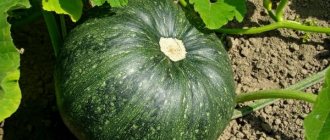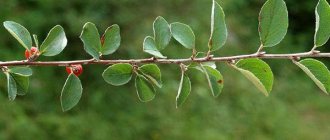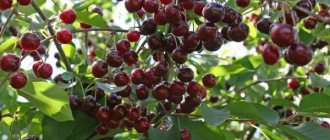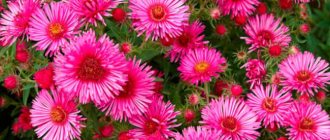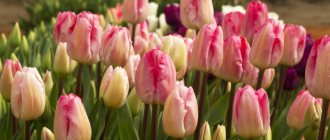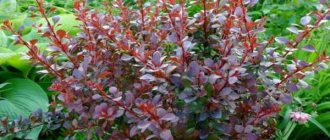Description: varieties and varieties of alpine aster
Aster is one of the most common flowers used in landscape design in open ground and in summer cottages. These flowers delight the eye from spring to late autumn.
Unpretentious bright asters delight the eye of gardeners with their simplicity and grace
The first of the aster family to bloom at the end of May is the perennial alpine aster - a spring-summer flowering plant, up to 25-30 cm high. Typically, the lush flowering of asters lasts more than three to four weeks. Alpine aster flower rosettes are medium in size (do not exceed 4-6 cm in diameter), located one per stem. The shape and arrangement of the petals of the alpine aster resembles a chamomile, which is why it is sometimes called alpine chamomile. This flower is perfect for decorating the foot of an alpine hill and is frost-resistant.
The aster looks very beautiful next to the stones
The variety of colors of the alpine perennial aster contributes to its active use in landscape design. Breeders have developed many varieties of alpine aster with different colors of flower baskets: there are dark purple, bluish-violet, light and dark pink, bright orange flowers.
The most common varieties of alpine aster:
- “Albus” is a low white aster, blooms in the first two months of summer, the stems are short (no higher than 15-20 cm), densely dotted with leaves;
Variety "Albus"
- “Gloria” - flower rosettes are painted in blue tones, inflorescences do not exceed 3 cm in diameter;
Variety "Gloria"
- "Goliath" is distinguished by light purple flower rosettes about 6 cm in diameter. It blooms for about a month, the beginning of flowering is June;
Variety "Goliath"
- "Rosea" - a pink flower, flower rosettes up to 4 cm in diameter;
Variety "Rosea"
- "Happy End" is distinguished by strong, straight stems, abundantly covered with leaves. It blooms in May, the flowering period is quite long - about a month;
Variety "Happy End"
- "Dunkle Schöne" - a spectacular dark purple aster, inflorescences about 3 cm;
Variety "Dunkle Schöne"
- “Ruber” is an unusual red-pink aster, flower rosettes up to 4 cm;
Variety "Ruber"
- “Superbus” is an aster of lilac-blue tones, flower rosettes about 3.5 cm in diameter.
Variety "Superbus"
When and how does it bloom
On average, flowering of each variety lasts 30-45 days.
The inflorescence is a basket in which the central tubular flowers have short yellow corollas, and the outer tier is formed of long flowers of pink, white, blue, and purple. Some hybrids may have a basket entirely of one shade.
The shape of the inflorescence is usually similar to a daisy, whose long petals can have a simple, pointed shape with a wavy edge.
Most of the varieties available for sale bloom in May-June, but in nurseries you can also find others that bloom towards the end of summer.
When the bushes bloom, their water consumption increases significantly. If the rest of the time, if there is enough rain, the planting can not be watered at all, but during flowering, watering is necessary every week. If the seeds are not needed, dry flowers are removed to make the bushes look more beautiful.
Planting a plant
Before planting the plant in open ground, you need to choose a suitable location: all perennial asters love a well-lit sunny place. Before planting asters, it is recommended to fertilize the soil (phosphate preparations are used), dig it up, pick out all the weeds and moisten it.
Aster does not need any special care, just watering, loosening and a well-chosen place for planting
It is advisable to add about 200 g of lime (can be replaced with dolomite flour) and about 100 g of superphosphate to the soil before digging the soil and planting the aster. You should dig to a depth of 30 cm.
Attention! Damp, flooded soils are absolutely not suitable for planting asters. Under such conditions, the plant becomes infected with powdery mildew and simply dies.
Possible problems in growing
In general, with the right agricultural technology, the alpine aster does not cause trouble. The causes of possible problems are well studied.
If the green part of mountain asters begins to turn yellow, this indicates that the plant has been attacked by a disease or is drying out. Carry out preventive treatment with a suitable preparation and increase watering.
Important! Spider mites and aphids are the main pests of alpine asters. They are treated against them with the drug “Akarin”, which has a wide spectrum of action.
You can often see traces of powdery mildew on the bushes. Its source is excess nitrogen in the soil and damp weather. Reducing watering and treating with Topaz helps, and in the fall the bushes are sprayed with a solution of copper sulfate.
A small number of flowers and a pale appearance indicate a dense planting. With excess moisture, asters wither and quickly die. If the planting site is chosen too dark, then buds may not form at all.
Alpine aster is a favorite perennial among gardeners, varying in shades and bush sizes. You can choose an interesting variety for every garden!
Plant care
Alpine aster is a perennial, easy to care for. It is necessary to ensure timely watering of the plant (infrequently, but plentifully) and loosening the soil, weeding. Lack of moisture can lead to loss of decorative appearance of flower baskets and their drying out. Before flowering, it is recommended to hill the crop to a height of 5-6 cm, thus accelerating the growth of the root system and its strengthening. During the flowering period, it is necessary to remove dried plants.
Remove weeds from flower beds in a timely manner so that they do not interfere with the growth and development of the aster
The flower is frost-resistant, but for frosty winters it is recommended to mulch the perennial with soil or sand, taking into account that the plant buds must be covered.
Plant propagation
Alpine aster is propagated in two ways: by seeds and by dividing a bush that has been growing for a couple of years.
Aster seeds
seeds are collected in late autumn after flowering has ended, planted in fertilized soil and covered with film to obtain a greenhouse effect. The resulting seedlings germinate in March-April, after the first leaves appear. Asters grown from seeds bloom in open ground only in the second year. This propagation method is quite labor-intensive, since seed germination is low.
Dividing an aster bush (vegetative method) is a simple and quick method of propagation and planting new areas with flowers. It is necessary to separate part of the bush along with the rhizome in the spring after rapid growth begins, remove weak stems and replant it in a new place.
Advice. Aster can grow in one place for up to 7 years, but to renew the bush and maintain lush flowering, it is recommended to replant the crop every three years.
Alpine aster tolerates bush division quite well
be propagated by cuttings all summer long . The tops of the shoots are suitable for this; their recommended length is about 6 cm. The cuttings should be planted in specially prepared beds with special soil (turf soil, peat, sand in a ratio of 2 parts soil to 1 part peat and 1 part sand) in partial shade, covered with agrofibre. Rooting time for cuttings is about 1 month. Young shoots up to 15 cm tall, cut into several parts, each of which should have 3 leaves, can be used as cuttings. In August-September, such cuttings can be planted in a permanent place of growth.
Growing from seeds to seedlings
One of the most common methods of breeding alpine aster is by seed. Seeds can be sown directly in open ground or planted as seedlings. Then transplant it to a permanent place.
Deadlines
Seeds are sown for seedlings from the end of February and throughout March. Seedlings can be planted in open ground only after warming, usually in June. Everything depends on weather conditions.
Planting container and soil
Any containers (containers, pots, boxes) are suitable for planting. The main thing is that they have drainage holes for free flow of water. The soil should be nutritious, well fertilized, and also sufficiently loose. A mixture of garden soil with sand, peat or humus is suitable. You can buy ready-made flower substrate. Before use, the substrate must be disinfected with a solution of potassium permanganate (1:5). Place a layer of drainage (broken brick, expanded clay) on the bottom of the container.
Preparing and sowing seeds
Alpine aster seeds have a harder time germinating than annual varieties. Therefore, before planting, it is recommended to soak them for some time in a solution of a growth stimulator and disinfect them. Bury the seeds into the soil 1-1.5 cm. If these are small cups, then sow 2-3 pieces. When planting in a container or box, make rows, between which there should be a distance of 8 cm. Between each seed, the distance should be 5 cm. Sprinkle the seeds with soil on top.
Place the planting container on the south side, which is well lit. Water as needed. Do not allow an earthen crust to form on the surface.
There is another way to sow seeds for seedlings. Fill a plastic container with substrate. Spread the seeds on its surface. Pour boiling water over and cover the container with a transparent lid. Place in a warm place. When shoots appear, the lid can be removed.
How to care for seedlings
When the seeds germinate, the temperature is lowered to +16-18 degrees. Otherwise, the seedlings will become very stretched. When the plant has 3-4 true leaves, the seedlings can be planted. If the seeds are planted in cups, then picking is not necessary. The seedlings are immediately planted in open ground. Before this, it must be hardened. Periodically take the seedlings out into the fresh air when it becomes warm, increasing the time they spend outside.
Planting in open ground
When the time comes, the seedlings need to be planted in a permanent place. In the selected area, dig holes so that an earthen ball with seedlings can fit in them. The distance between them should be 20 cm, the row spacing should be 40 cm. The planting depth should be 2 cm greater than the seedlings were in the container. When the aster is planted, grooves need to be made between the rows, which are necessary to moisten the soil.
Diseases and pests
The alpine perennial aster is ideal for creating landscape design, is resistant to many diseases and pests, and is unpretentious in cultivation. However, in damp summers, if asters are improperly watered or planted in damp, waterlogged soil, the likelihood of the perennial becoming infected with powdery mildew increases sharply.
The disease is transmitted from plant to plant by air. The affected area depends on the density of asters and the presence of moisture on the leaves. In order to prevent this disease, it is recommended to treat flowers with Topaz twice before flowering. Topaz should be diluted at the rate of 2 ml of the drug per 10 liters of water.
Powdery mildew control agent
In the fall, it is recommended to treat alpine aster with copper sulfate (dilute 50 g of the drug in a standard 10-liter bucket of water), after which the plants need to be cut.
Infected shoots should be cut and burned, as the powdery mildew fungus can remain on the leaves and stems of the plant all winter, and in the spring it will release new spores and infect nearby flowers.
Biofungicides are used to treat asters:
- "Topaz".
- "Fitosporin".
- "Alirin" and "Gamair".
Copper sulfate and its solution for treating plants
There are other ways to protect plants:
- spraying with an ash solution (dilute 1 kg of wood ash in 10 liters of warm water, leave to infuse for 6-7 days. The drug is applied by spraying the leaf surface three times);
- treatment with a solution of laundry soap and copper sulfate (mix 100 g of laundry soap with 5 g of copper sulfate, treat the plants twice).
In addition, in the summer, during the active growth phase of the perennial, it is recommended to carry out three root feedings of the aster with stimulants. At the beginning of budding, asters are treated with the drug “Energen” (recommended dose: 1 capsule per half bucket of water). Then, during flowering, you need to give a second dose: the drug “Agricola for flowering plants” is used (about 30-35 g per bucket of water). The third time the plant is fed in August with potassium sulfate: 30 g per bucket of water.
Alpine aster: combination with other plants
Alpine aster blooms for quite a long time; it can serve as a background for other flowers, gradually replacing each other from spring to autumn.
Asters of different colors can look great in a flowerbed.
Border irises, cypress spurge, evening primrose, multicolored spurge, and dotted loosestrife, which are painted in bright yellow, look impressive against the background of purple asters. The combination of bearded irises and alpine asters looks interesting - by planting blue or lilac varieties nearby, you can create a composition that is pleasing to the eye, playing on a smooth change of halftones.
Astra goes well with:
- violets;
- geraniums;
- large sedum;
- prominent sedum;
- white woodwood;
- incense;
- Thunberg barberries;
- Spiria japonica.
Alpine aster in a flower bed
Experienced gardeners willingly include Julia primrose, reed grass, spartina, and creeping thyme in a composition with alpine aster. Successful partners for perennial aster are ornamental grasses.
Alpine aster in landscape design
Since the perennial alpine aster is quite unpretentious in cultivation, it is actively used in landscape design by gardeners and simply lovers of wildlife in flower beds, rock gardens, in the design of flower beds, rocky hills, as a balcony plant.
It is recommended to plant alpine asters in the foreground of shrub plantings, in borders, and to decorate the banks of small garden or country ponds.
The perennial alpine aster is equally loved by experienced landscape designers and amateur gardeners. It is easy to care for, does not require special watering conditions, but at the same time it delights almost the whole summer with bright colors, emphasizing the beauty of the surrounding nature. Give your attention to the alpine aster, and it will reward you with lush flowering.
Planting perennial asters: video
Alpine aster: photo
Perennial bush aster
Tall varieties should be grown to decorate flower beds or to create hedges. If the perennial is low-growing, then it is suitable for borders or small flower beds.
Depending on their appearance and flowering period, perennial asters are divided into several categories. At the beginning of summer, the Alpine aster begins to delight with its flowering, and at the end of the hot season, you can enjoy the unforgettable flowers of Italian varieties.
With the onset of autumn, the previous varieties are replaced by bush asters, blooming flowers of the most unpredictable and beautiful shades.
Types of perennial plants:
Alpine aster photo.
The height of this short species does not exceed 30 cm. It first appeared in the Alps. The flowers of the plant are located on one shoot and their circumference can vary from 4 cm to 6 cm; they are similar in appearance to chamomile. The double center of the flowers is yellow and has tubular petals. There are pink, purple and white shades of flowers. It blooms in early June and pleases others with its lush blooms throughout the month. The alpine aster flower is a perennial planting and caring for which is not at all difficult, will delight you with its flowering for a long time.
It can serve as an excellent decoration for alpine hills or in flowerbed arrangements next to low-growing plants.
Common varieties:
- Wargrave is a dwarf subspecies, barely reaching 25cm. It is a May flower, with pink daisy petals and an amber center.
- Glory. Even smaller than Vargrav. With a bright orange center and sky blue long petals (about 4 cm).
- Helen beauty Perennial alpine subspecies of dwarf growth 10-15cm. Small flowers in rich purple shades. It turns out to be an interesting combination with Iberis and Chinese carnation flowers.
- Albus - consists of multiple virgin white inflorescences.
- Dark Beauty Border Aster is dark purple in color, blooms in the last days of July and continues to bloom until mid-August.
- Galiath is a true alpine aster, often used for its intended purpose - on an alpine hill; it is also planted along paths and for rockeries. Long-lasting flowering with unusual lavender flowers.
Shrub or bush.
This species was bred in North America. All varieties that you will find in it have 20-60 cm shoots that are completely covered with foliage.
The bush aster is a species that will be the first to bloom in the autumn.
The most popular bush varieties include:
- Blue Bird is a low-growing specimen (up to 20cm) with sky-blue petals in the form of elongated tongues.
- Alba flor foam is a medium-sized type. It is distinguished by a different structure of petals, some are lemon-yellow tubular, while others are in the form of snow-white tongues.
New England aster.
With the onset of autumn, asters will delight you with their rich inflorescences, the diameter of which is about 4 cm. These flowers can be used to create unforgettable bouquet arrangements that can survive in water for several weeks.
- Perple House purple - lavender flower colors
- Apollo white Chinese aster
- Andenken & Alma Potschke bright pink petals coupled with a yellow spot in the middle, excellent pink asters
New Belgian aster.
The height of these plants can vary from 35 cm and reach 1.5 meters.
There are dwarf (miniature), medium-sized and tall New Belgian aster.
- Marie Ballard Blue Aster
- Royal Ruby deep red
- Patricia Ballard dark pink aster
- Royal ruby red-ruby color
- Winston Churchill burgundy - red
- White Ladies snow-white flowers
Italian aster.
It is a bush no larger than 70 cm. You can find pink, lilac, yellow or dark blue flowers collected in basket inflorescences. In August it begins to delight its owners with lush and abundant flowering.
- Italian Rudolf Goethe double lilac - pinkish inflorescences
- Amalia or chamomile or European
- Dwarf

